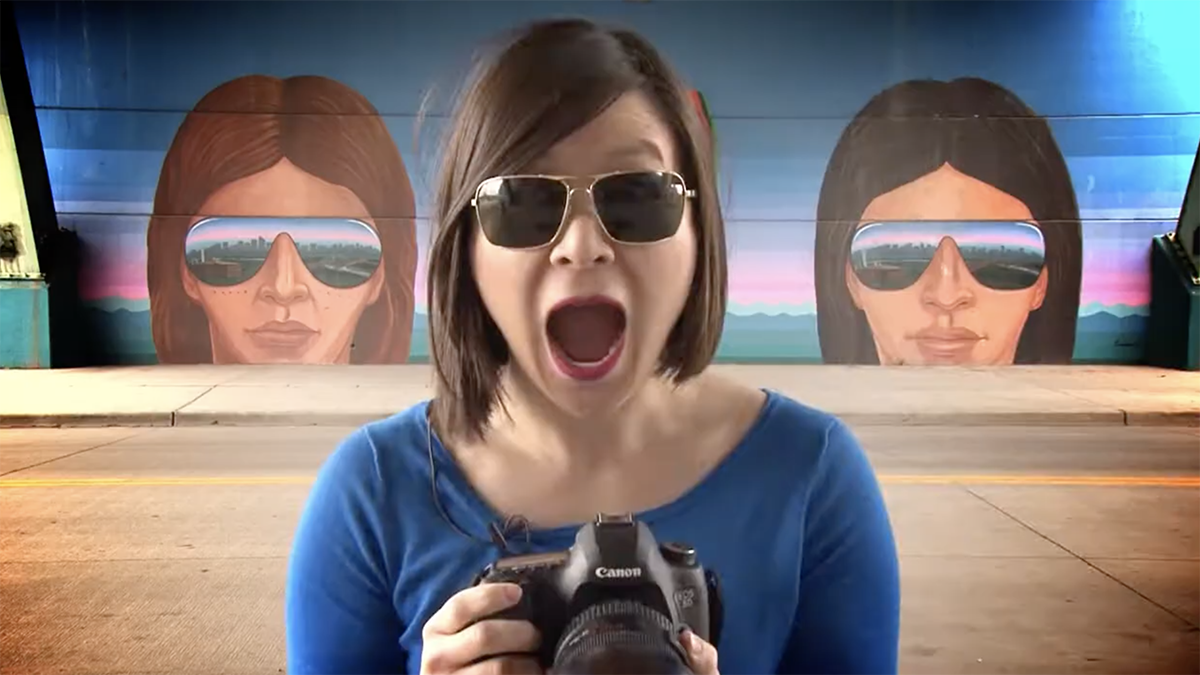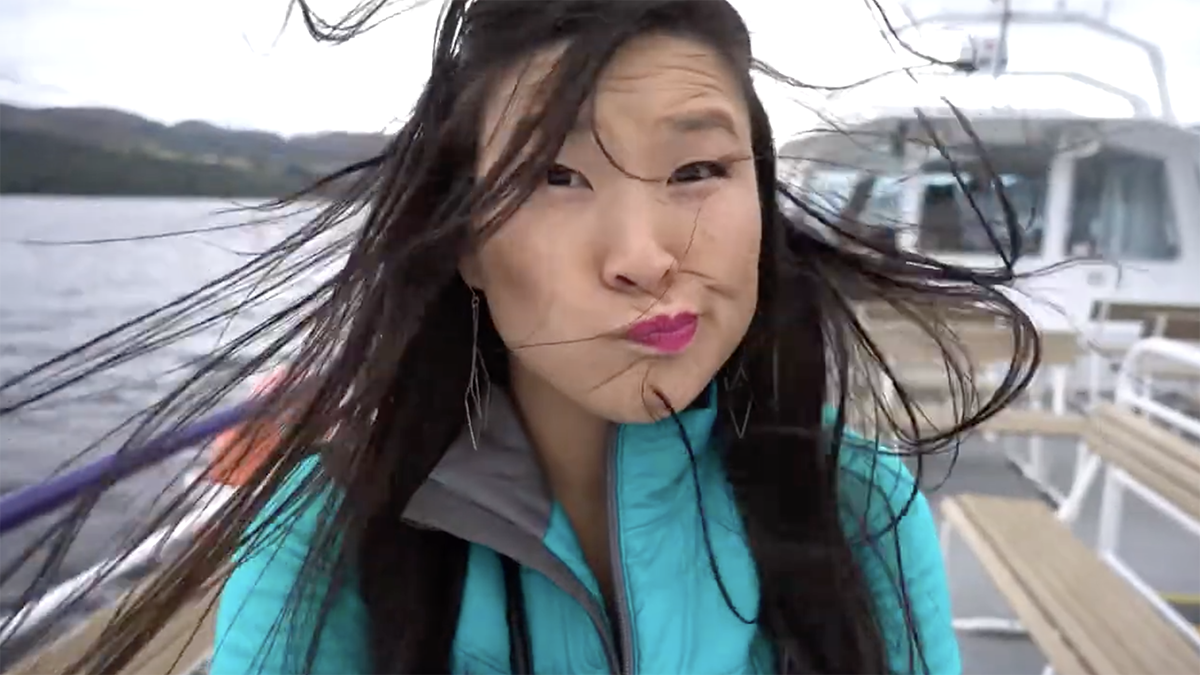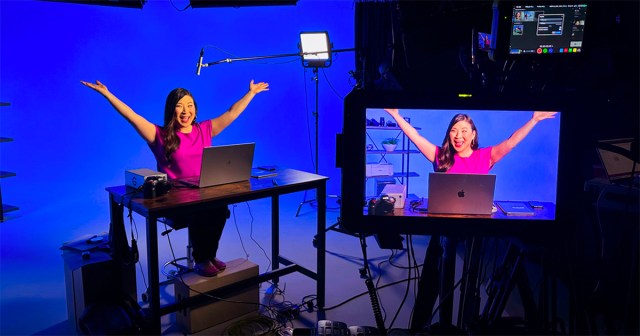TL;DR
- Filmmaker and host Juliana “Traveling Jules” Broste offers tips for creating an effective and practical studio while traveling.
- Even if you’re just logging on to Zoom calls, remember that first impressions matter a lot. A well-lit, crystal clear image helps you stand out. It’s also professional in a way that’s especially important if you work in media.
- Broste shares her gear list, including some items she typically leaves at home.
Filmmaker and host Juliana “Traveling Jules” Broste shared tips for creating “Your Studio On-the-Go” at the 2023 NAB Show New York. Watch her full presentation above.
What to Bring
“I have different size kits for different applications,” Broste says. She also notes that what she brings will depend on her mode of travel; she’ll bring more gear if she’s going by car than she will when flying, for example.
When creating her studio, Broste says, “I use, for example …my Canon EOS R. I have a tripod. I set up a teleprompter… in front of the lens. And underneath the lens you’ll see a little output, a 12 inch monitor, which is connected to my camera.” You’ll also need the “cable to attach [your devices], whether it’s USB-C or HDMI.”
Also, make sure “you have a clean HDMI out so that the picture in the Zoom call or the picture that you’re recording is not going to have words and numbers and F stop and ISO and all that weird focus box around your face.”
Some cameras, Broste says, have software “where you plug it in and it just works,” but if that’s not the case, she recommends “cam link by Elgato, something like that, like a dongle can easily make your camera now compatible with your computer.”
Whether or not you’re going with a single-camera set up, Broste recommends the HA10 Mini Pro, which she says “is an amazing switcher.” She adds, “It’s like a one stop shop. You plug it in and everything works.” Broste goes so far as to say, “If you’re on the move, that is the indispensable item.”
Remember Your First Impression
That’s a list of what Broste will use, even for Zoom calls, because “this type of setup just to give you that edge and especially if you have extra gear or you’re upgrading this is a good place to put it on to use,” Broste explains.
After all, “imagine that first impression when you get on the Zoom call. And you are just crystal clear. And you are lit well, and exactly the job that you do in video production is represented in that one shot. It’s important, right? We want to represent ourselves first impressions matter.”
Alternatively, you may use your laptop and a webcam, and Broste says, “I definitely have a stand to make it a little higher so that the camera’s at eye level.”
Also, if you’re using a laptop, “a second screen can be helpful. It makes you feel like you’re at home with that extra monitor.”
One use for that second screen? A teleprompter app. Broste uses Teleprompter Plus, or she also has the Prompter People 10-inch and a Lilliput monitor.
Other Best Practices
And don’t forget your sound. “I definitely recommend investing in audio,” Broste says.
After all, “if you sound crappy, you can’t hear anything. What’s the point?”
Keep in mind, “not all camera microphones go directly into the computer.” But, she says, one TRS cable “has three rings so that it has headphone capability, the other one has only two rings” and can help your set up.
If you’re using a camera, consider that “cold shoe mounts are going to give you a really good flexibility to have both a microphone and a light.”
Also useful, is a Wi Fi remote. Broste considers hers to be “an indispensable tool that I use with my Canon cameras.” You can also use your phone to connect to your camera, even changing exposure or to preview your shot.
“Make sure you have continuous power. I learned that it’s actually two things. It’s a AC adapter and a coupler. The coupler looks like a battery goes in the camera, but it has a cord and that powers it,” she says.
Broste adds that she relies on “the Anker. It’s quite a large but very portable power bank,” which she likes enough that she says she “stopped bringing any other charges except this one because it always saves me when I’m in a pickle.”
She recommends some lightweight stands, which can be either aluminum or carbon fiber, noting that some are more travel-friendly than others and some also have more features to recommend them.
What to (Maybe) Skip
“I, personally, try not to travel with lights,” she says.
Instead, Broste will “position my face towards the window” when recording. But that doesn’t mean you can’t bring lighting with you, and it definitely doesn’t mean you should ignore it.
She does, however, “really like this Manfrotto collapsible reversible background, which [is] kind of like a reflector,” Broste says.
“Also, you might need lights, fans,” she says, but “I try not to travel with these again, because there’s just so much extra stuff.”
Travel Best Practices
Broste also shared advice for traveling with your kit. “The on-the-go lifestyle, it starts right here when you’re on the road,” she says.
First, Broste recommends to invest in Apple Air Tags or similar tracking devices to keep a virtual eye on your bags.
Next, consider your connectivity if you’re traveling outside your home country. She recommend “that you have an international plan for your phone” or consider getting “local SIM cards because it can get expensive to stay connected.” If you do this and plan ahead, “you get off the plane and you already are connected.”
Also, keep in mind that “you have to be the mule and carry all this stuff. And then you get to benefit from the high quality production.” Whatever you pack, if you’re a solo traveler, you’ll have to carry — but then you also get to use it.
While she says, “I rarely travel with this roller cart. But that’s also very helpful” because “you don’t have to have all that weight on your back.” However, Broste emphasizes, “You have to make space for that.”
For her own travel, she says, “Most of the stuff I do is this, it’s [a] backpack. It’s pretty, pretty lean and mean, my backpack might weigh 30 pounds. But I fit it all into one backpack. And also, if you’re feeling like traveling with your gear is weighing you down, think about how that’s gonna feel after one hour, three hours, nine hours later, it’s going to get heavier, right? So it’s always best to only bring what you need.”




